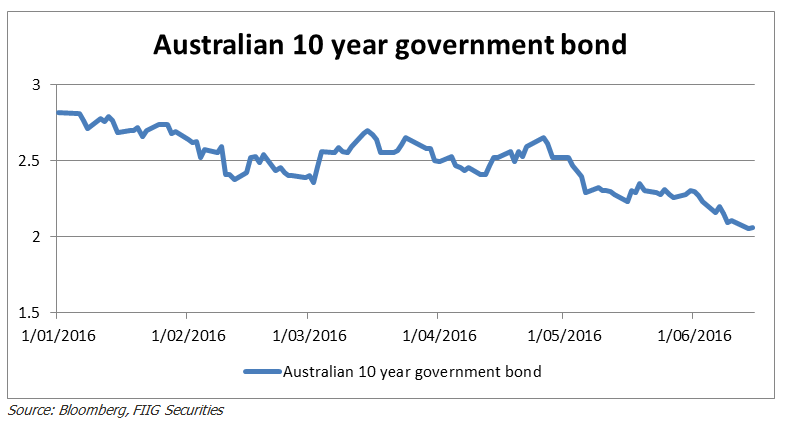Britain’s crucial Brexit vote takes place on Thursday. Markets are getting progressively more nervous as polls converge, with investors realising it will take years to disengage from the EU and the drag this will have on trade and global growth if they decide to go
Should the “leave” vote win, the implications are widespread and unquantifiable. Risk and contagion are severe. High on the list must be other countries seeking to exit and if another one of the majors such as Spain or Italy leaves, it is more likely others would follow.
The “stay” vote would have a calming effect but the raft of other possible disruptors to financial markets for the rest of the year is high. The most obvious being the US election and a Trump victory.
In times of heightened volatility, investors sell out of high risk assets and prefer to hold low risk ones such as government and highly rated corporate bonds. Capital preservation comes to the fore; investors don’t want to lose substantial capital if asset prices fall.
Possibly the best investment in a volatile market is government bonds; they are one of institutional investors’ favourite safe haven plays. The handful of governments that have a AAA credit rating are best but many of these are trading at negative yields over considerable parts of the yield curve. This suggests that bond investors are more worried about deflation than investors in other asset classes. They are willing to sacrifice a small but defined capital loss by investing in a AAA rated sovereign bond with a negative interest rate.
In comparison, our AAA rated Australian Commonwealth government 10 year bonds still look attractive on a global basis with yields slightly over 2 percent per annum as of 16 June. Since the start of the year, yields on these bonds have declined by 0.86 percent or close to 30 percent – dispelling repeated calls for a bursting of the bond bubble over the last few years.
Unfortunately, there’s nothing on the immediate horizon to suggest any reversal of the downward trend.

Institutional investors recognise the possible ramifications of a Brexit and are repositioning their portfolios, selling more volatile assets like shares in favour of bonds.
Generally, investors now appreciate that interest rates are going to be lower for longer but if Britain votes to exit the EU, interest rates will be lower for much longer than anyone expects.
The logical response is to invest in a fixed rate investment and fixed rate bonds fit perfectly because the terms to maturity can be many years and provide a certain income stream, countering the low interest rate environment.
Demand for fixed rate bonds is high. While few of our clients would choose to invest in government bonds, any fixed rate corporate bond, whether it has a very high credit rating or a low one, continues to be in demand and prices across the board keep increasing and yields decreasing. The opposite though is also true, if interest rates rise, fixed rate bond prices would fall.
For example an investment grade Qantas bond maturing in May 2022, six years from now, issued with at a face value of $100 and a yield of 7.75 percent, is trading at a price of $118.55 and current yield to maturity of 4.18 percent per annum.
While interest rates are very low and are likely to remain so for a long time, I am comfortable suggesting investors lock in a portion of their fixed income allocation into longer dated fixed rate securities.
One of the best options is a new Westpac subordinated fixed rate bond with a yield to call of 4.38 percent per annum. This is a very attractive rate for middle market clients such as charities and schools looking for certainty of income and capital as well as high net worth investors. Current minimum parcels are $200,000.
Another suggestion is a lower risk senior Rabobank bond maturing in April 2024, paying a fixed rate of 3.34 percent per annum, available to wholesale investors only in minimum parcels of $10,000.
Aside from the proximity of Brexit, there are plenty of risks that may continue to drive prices of fixed rate bonds higher. Out of favour, inflation linked bonds that also have a fixed rate component haven’t seen the same price appreciation, but I think this is just a matter of time.
If you are worried about interest rates and don’t like volatility, bonds could be the answer as:
They are legal obligations and interest and principal must be paid unless the company goes into wind up or liquidation.
Australian government bonds are considered “zero risk” – the government collects taxes and prints money and are not impacted by economic swings. Investors are assured of capital being paid at maturity.
While interest rates are low, many corporate bonds deliver a return that is now a multiple of the government bond rate. Years ago it would have been a percentage increase; so many corporate bonds remain very good relative value.
Many corporations have debt maturity profiles in good order. They’ve accessed the funds they need at relatively low interest rates so risk of default is low, and we continue to expect them to pay interest and return capital when due.
Originally published in The Australian on 21 June 2016








